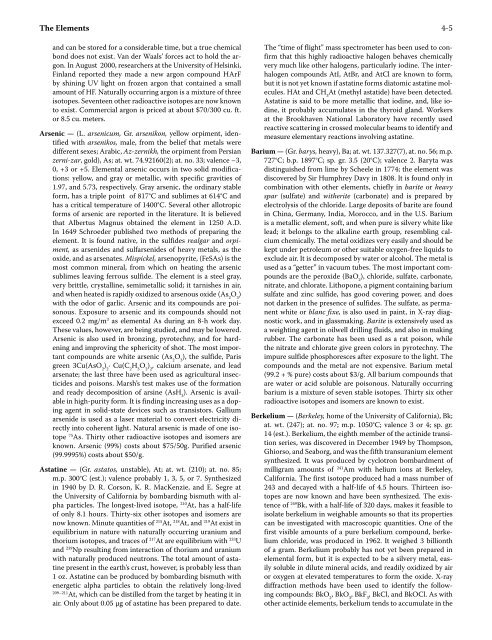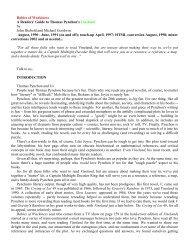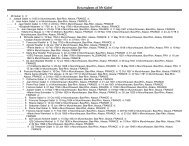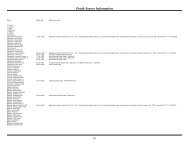CRC Handbook of Chemistry and Physics, 86th Edition
CRC Handbook of Chemistry and Physics, 86th Edition
CRC Handbook of Chemistry and Physics, 86th Edition
You also want an ePaper? Increase the reach of your titles
YUMPU automatically turns print PDFs into web optimized ePapers that Google loves.
The Elements 4-5<br />
<strong>and</strong> can be stored for a considerable time, but a true chemical<br />
bond does not exist. Van der Waals’ forces act to hold the argon.<br />
In August 2000, researchers at the University <strong>of</strong> Helsinki,<br />
Finl<strong>and</strong> reported they made a new argon compound HArF<br />
by shining UV light on frozen argon that contained a small<br />
amount <strong>of</strong> HF. Naturally occurring argon is a mixture <strong>of</strong> three<br />
isotopes. Seventeen other radioactive isotopes are now known<br />
to exist. Commercial argon is priced at about $70/300 cu. ft.<br />
or 8.5 cu. meters.<br />
Arsenic — (L. arsenicum, Gr. arsenikon, yellow orpiment, identified<br />
with arsenikos, male, from the belief that metals were<br />
different sexes; Arabic, Az-zernikh, the orpiment from Persian<br />
zerni-zar, gold), As; at. wt. 74.92160(2); at. no. 33; valence –3,<br />
0, +3 or +5. Elemental arsenic occurs in two solid modifications:<br />
yellow, <strong>and</strong> gray or metallic, with specific gravities <strong>of</strong><br />
1.97, <strong>and</strong> 5.73, respectively. Gray arsenic, the ordinary stable<br />
form, has a triple point <strong>of</strong> 817°C <strong>and</strong> sublimes at 614°C <strong>and</strong><br />
has a critical temperature <strong>of</strong> 1400°C. Several other allotropic<br />
forms <strong>of</strong> arsenic are reported in the literature. It is believed<br />
that Albertus Magnus obtained the element in 1250 A.D.<br />
In 1649 Schroeder published two methods <strong>of</strong> preparing the<br />
element. It is found native, in the sulfides realgar <strong>and</strong> orpiment,<br />
as arsenides <strong>and</strong> sulfarsenides <strong>of</strong> heavy metals, as the<br />
oxide, <strong>and</strong> as arsenates. Mispickel, arsenopyrite, (FeSAs) is the<br />
most common mineral, from which on heating the arsenic<br />
sublimes leaving ferrous sulfide. The element is a steel gray,<br />
very brittle, crystalline, semimetallic solid; it tarnishes in air,<br />
<strong>and</strong> when heated is rapidly oxidized to arsenous oxide (As 2 O 3 )<br />
with the odor <strong>of</strong> garlic. Arsenic <strong>and</strong> its compounds are poisonous.<br />
Exposure to arsenic <strong>and</strong> its compounds should not<br />
exceed 0.2 mg/m 3 as elemental As during an 8-h work day.<br />
These values, however, are being studied, <strong>and</strong> may be lowered.<br />
Arsenic is also used in bronzing, pyrotechny, <strong>and</strong> for hardening<br />
<strong>and</strong> improving the sphericity <strong>of</strong> shot. The most important<br />
compounds are white arsenic (As 2 O 3 ), the sulfide, Paris<br />
green 3Cu(AsO 2 ) 2 · Cu(C 2 H 3 O 2 ) 2 , calcium arsenate, <strong>and</strong> lead<br />
arsenate; the last three have been used as agricultural insecticides<br />
<strong>and</strong> poisons. Marsh’s test makes use <strong>of</strong> the formation<br />
<strong>and</strong> ready decomposition <strong>of</strong> arsine (AsH 3 ). Arsenic is available<br />
in high-purity form. It is finding increasing uses as a doping<br />
agent in solid-state devices such as transistors. Gallium<br />
arsenide is used as a laser material to convert electricity directly<br />
into coherent light. Natural arsenic is made <strong>of</strong> one isotope<br />
75 As. Thirty other radioactive isotopes <strong>and</strong> isomers are<br />
known. Arsenic (99%) costs about $75/50g. Purified arsenic<br />
(99.9995%) costs about $50/g.<br />
Astatine — (Gr. astatos, unstable), At; at. wt. (210); at. no. 85;<br />
m.p. 300°C (est.); valence probably 1, 3, 5, or 7. Synthesized<br />
in 1940 by D. R. Corson, K. R. MacKenzie, <strong>and</strong> E. Segre at<br />
the University <strong>of</strong> California by bombarding bismuth with alpha<br />
particles. The longest-lived isotope, 210 At, has a half-life<br />
<strong>of</strong> only 8.1 hours. Thirty-six other isotopes <strong>and</strong> isomers are<br />
now known. Minute quantities <strong>of</strong> 215 At, 218 At, <strong>and</strong> 219 At exist in<br />
equilibrium in nature with naturally occurring uranium <strong>and</strong><br />
thorium isotopes, <strong>and</strong> traces <strong>of</strong> 217 At are equilibrium with 233 U<br />
<strong>and</strong> 239 Np resulting from interaction <strong>of</strong> thorium <strong>and</strong> uranium<br />
with naturally produced neutrons. The total amount <strong>of</strong> astatine<br />
present in the earth’s crust, however, is probably less than<br />
1 oz. Astatine can be produced by bombarding bismuth with<br />
energetic alpha particles to obtain the relatively long-lived<br />
209–211 At, which can be distilled from the target by heating it in<br />
air. Only about 0.05 µg <strong>of</strong> astatine has been prepared to date.<br />
The “time <strong>of</strong> flight” mass spectrometer has been used to confirm<br />
that this highly radioactive halogen behaves chemically<br />
very much like other halogens, particularly iodine. The interhalogen<br />
compounds AtI, AtBr, <strong>and</strong> AtCl are known to form,<br />
but it is not yet known if astatine forms diatomic astatine molecules.<br />
HAt <strong>and</strong> CH 3 At (methyl astatide) have been detected.<br />
Astatine is said to be more metallic that iodine, <strong>and</strong>, like iodine,<br />
it probably accumulates in the thyroid gl<strong>and</strong>. Workers<br />
at the Brookhaven National Laboratory have recently used<br />
reactive scattering in crossed molecular beams to identify <strong>and</strong><br />
measure elementary reactions involving astatine.<br />
Barium — (Gr. barys, heavy), Ba; at. wt. 137.327(7), at. no. 56; m.p.<br />
727°C; b.p. 1897°C; sp. gr. 3.5 (20°C); valence 2. Baryta was<br />
distinguished from lime by Scheele in 1774; the element was<br />
discovered by Sir Humphrey Davy in 1808. It is found only in<br />
combination with other elements, chiefly in barite or heavy<br />
spar (sulfate) <strong>and</strong> witherite (carbonate) <strong>and</strong> is prepared by<br />
electrolysis <strong>of</strong> the chloride. Large deposits <strong>of</strong> barite are found<br />
in China, Germany, India, Morocco, <strong>and</strong> in the U.S. Barium<br />
is a metallic element, s<strong>of</strong>t, <strong>and</strong> when pure is silvery white like<br />
lead; it belongs to the alkaline earth group, resembling calcium<br />
chemically. The metal oxidizes very easily <strong>and</strong> should be<br />
kept under petroleum or other suitable oxygen-free liquids to<br />
exclude air. It is decomposed by water or alcohol. The metal is<br />
used as a “getter” in vacuum tubes. The most important compounds<br />
are the peroxide (BaO 2 ), chloride, sulfate, carbonate,<br />
nitrate, <strong>and</strong> chlorate. Lithopone, a pigment containing barium<br />
sulfate <strong>and</strong> zinc sulfide, has good covering power, <strong>and</strong> does<br />
not darken in the presence <strong>of</strong> sulfides. The sulfate, as permanent<br />
white or blanc fixe, is also used in paint, in X-ray diagnostic<br />
work, <strong>and</strong> in glassmaking. Barite is extensively used as<br />
a weighting agent in oilwell drilling fluids, <strong>and</strong> also in making<br />
rubber. The carbonate has been used as a rat poison, while<br />
the nitrate <strong>and</strong> chlorate give green colors in pyrotechny. The<br />
impure sulfide phosphoresces after exposure to the light. The<br />
compounds <strong>and</strong> the metal are not expensive. Barium metal<br />
(99.2 + % pure) costs about $3/g. All barium compounds that<br />
are water or acid soluble are poisonous. Naturally occurring<br />
barium is a mixture <strong>of</strong> seven stable isotopes. Thirty six other<br />
radioactive isotopes <strong>and</strong> isomers are known to exist.<br />
Berkelium — (Berkeley, home <strong>of</strong> the University <strong>of</strong> California), Bk;<br />
at. wt. (247); at. no. 97; m.p. 1050°C; valence 3 or 4; sp. gr.<br />
14 (est.). Berkelium, the eighth member <strong>of</strong> the actinide transition<br />
series, was discovered in December 1949 by Thompson,<br />
Ghiorso, <strong>and</strong> Seaborg, <strong>and</strong> was the fifth transuranium element<br />
synthesized. It was produced by cyclotron bombardment <strong>of</strong><br />
milligram amounts <strong>of</strong> 241 Am with helium ions at Berkeley,<br />
California. The first isotope produced had a mass number <strong>of</strong><br />
243 <strong>and</strong> decayed with a half-life <strong>of</strong> 4.5 hours. Thirteen isotopes<br />
are now known <strong>and</strong> have been synthesized. The existence<br />
<strong>of</strong> 249 Bk, with a half-life <strong>of</strong> 320 days, makes it feasible to<br />
isolate berkelium in weighable amounts so that its properties<br />
can be investigated with macroscopic quantities. One <strong>of</strong> the<br />
first visible amounts <strong>of</strong> a pure berkelium compound, berkelium<br />
chloride, was produced in 1962. It weighed 3 billionth<br />
<strong>of</strong> a gram. Berkelium probably has not yet been prepared in<br />
elemental form, but it is expected to be a silvery metal, easily<br />
soluble in dilute mineral acids, <strong>and</strong> readily oxidized by air<br />
or oxygen at elevated temperatures to form the oxide. X-ray<br />
diffraction methods have been used to identify the following<br />
compounds: BkO 2 , BkO 3 , BkF 3 , BkCl, <strong>and</strong> BkOCl. As with<br />
other actinide elements, berkelium tends to accumulate in the







